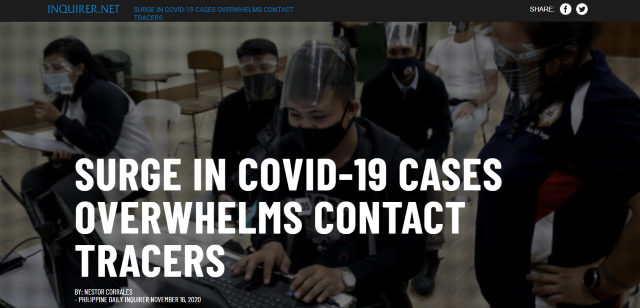Another LGU best practice: Inquirer reports Valenzuela’s contact tracing

CHEERS TO the Philippine Daily Inquirer for a two-part series that featured a local government’s approach to contact tracing. This important measure against COVID-19 has been underappreciated by the national government since the pandemic began, but Valenzuela City has shown how this can be done efficiently on a smaller scale, setting an example for other local government units to follow.
Part 1, “Surge in COVID-19 cases overwhelms contact tracers,” provided an overview of the challenges to the country’s contact tracing system. Citing contact tracing czar and Baguio City Mayor Benjamin Magalong, the report said LGUs are faced with a shortage in contact tracers since the Health department passed the responsibility to them in April. The report noted that PHP5 billion was given to the DILG under the Bayanihan to Recover as One Act, for purposes of hiring and training contact tracers. This law was signed on September 11.
Magalong told the Inquirer that Valenzuela City has “very good contact tracing.” Discussing the system with Mayor Rex Gatchalian, the report described the city’s approach:
- A mega contact tracing center operating 24/7 was established in August, manned by at least 100 personnel. It functions as a call center where residents can report to “agents,” who would walk them through a “triage” over the phone and determine what steps need to be taken afterwards. This includes swab testing, which the city administers for free.
- Valenzuela’s epidemiological unit performs home swabbing. Police and barangay officials are tapped to ensure that the swabbed residents stay at home while waiting for their results. Gatchalian said they also give the household a week’s worth of food in case the results are delayed, but he added that the newly-opened molecular laboratory of the city would yield faster test results.
- Individuals who tested positive are put in isolation units, because the city has strict prohibitions on home quarantine. Further contact tracing would then be done through the patient’s “self-assessment,” then surveillance officers would do validation on the ground.
Part 2, titled ‘It’s a medical emergency, so our response should be medical,‘ reported Valenzuela City’s mobilization of medical professionals in conducting training for contact tracers. Gatchalian said the city epidemiologist himself leads the training, which runs from one to two days.
The mayor added that on the average, the city is able to trace 20 contacts per individual. Gatchalian said that Valenzuela City already achieved the 2-percent swab testing quota in July.
The second part of the series again referred to Magalong, who raised the concern that many LGUs still lack digital recording systems for COVID-19 cases, as well as the inactive involvement of some local chief executives in activities addressing COVID-19.
At this point in the pandemic, the public and the country’s leaders cannot afford to ignore resources and strategies that have shown promise and efficiency in curbing COVID-19.
Journalists should follow up on the experience of Valenzuela and have the experts connect the contact tracing system to the over-all impact on curbing the disease, which means reviewing the data gathered so far from various points of analysis.
Leave a Reply